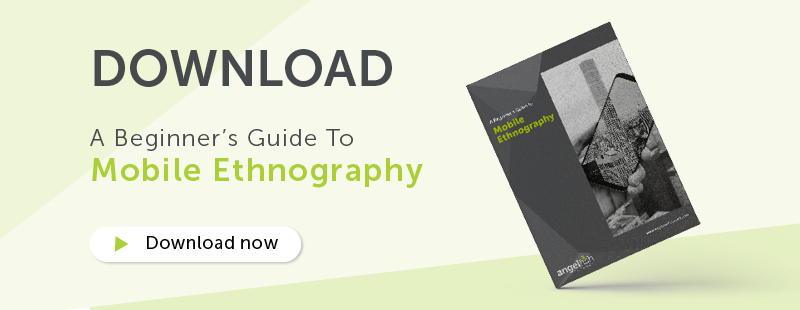
The power of storytelling in qualitative market research
Market research is evolving.
Research is becoming more diverse, Generation Z is coming of age, and new demographics such as the ‘Otherhood’ are becoming increasingly important.
At the same time, the need to understand the customer is greater than ever before too - which means it’s absolutely vital that everyone’s voice is heard, that consumers’ opinions are respected and taken on board, and that brands communicate with all of their customers, no matter who they are.
But how? The trouble is, we currently live in a world that’s data rich yet insight poor. Let’s face it - people aren’t predictable, and data alone isn’t enough to get to know what makes them tick.
So, if researchers really want to start understanding why customers behave the way they do, they need to start looking at the people behind the studies. Basically, in order to unlock real, actionable insights, we need to start storytelling in market research...
Times are changing
In order to truly understand your customers, you need to really listen to them. Humans are not rational information processors and we can’t use data to second-guess them. Instead, we need to focus on unlocking insights and understanding what really drives their behaviour.
After all, not every insights question can be solved with a survey, and when it comes to in-depth insights, nothing beats truth - especially when it comes from a genuine, human source.
And it’s this level of insight that can allow researchers to understand and share powerful customer stories so they can illustrate key outcomes, grab the attention of executives, and make more informed customer-centric decisions.

The shift to storytelling and the new rules of research
As organisations evolve to become more customer-centric, they often struggle to keep up with the research demand and tell a meaningful story with the huge amount of data they have. Decision makers today are sick of statistics and bored of bar charts.
But if numbers numb us, then stories stir us: stories translate information into emotion and create empathy, trumping statistics every time and making your findings and conclusions infinitely more impactful. So in order to unlock real meaning and drive change, we need to start telling more stories and excite stakeholders - and fast.
As we mentioned above, current trends in the research industry drive the need for more and better quality data - as well as smarter ways to collect it. Online communities, mobile-first surveys, digital ethnography, video research, UX testing - the rise of all these methods show that digital qual has finally come into its own.
And these modern methodologies have completely changed the way research is being conducted. Market researchers can now connect with consumers in an entirely new way - a way that fits in around people’s busy lives so they are no longer restricted by traditional research methods, and delivers interesting, in-depth results.
Here's how to incorporate storytelling in your market research projects:
1. Engaging and fun ethnography
We can now use mobile ethnography to conduct video interviews on the fly, get a front-row seat to accompanied shops without needing to leave the office, take in-home observational studies to the next level or have consumers record video diaries from the comfort of their homes.
Mobile ethnography essentially provides a fun and engaging way for participants to share their story - and because participants tend to feel more relaxed without a researcher next to them, it gives access to deeper insight than traditional methodologies, too.

2. Making waves with MROCs
Online communities are growing in popularity by the day. MROCs involve respondents completing a range of tasks and activities via a mobile device, and provide an easy and convenient way for respondents to take part in research without any geographical limitations.
Not only that, but because you can offer a variety of different tasks to keep your participants interested and engaged, online communities are also great fun!
3. Improved experiences with UX testing
Today’s customers know what they want - and UX testing is a fantastic way for researchers to get to grips with what consumers really want and need.
From making sure your website is easy to navigate to ensuring apps are user-friendly, UX testing allows researchers to really understand the customer journey, so brands can make the necessary changes and improve their overall customer experience.
What do all these methodologies have in common? They make the customer story more accessible than ever before. Digital methods help researchers gather in-depth, in-the-moment feedback from a range of customers, not just a small sample - which means it’s also easier to reach more diverse sample sizes.
And that’s not all: digital methods are fun, and they’re also great for reaching out to younger audiences, too. It’s all about engaging with your respondents so they want to take part in your research, empowering them to tell their stories so you can get closer to what your consumers really think.

4. Engaging with stakeholders
Once you’ve gathered your information, technology is allowing researchers to share that insight in new and exciting ways.
Instead of overloading decision makers with yet more numbers and statistics, by sharing video voxpops or interesting infographics, you can grab the attention of your executives and ensure they sit up and take notice.
At the most basic level, the brain is trained to find the easiest connection between cause and effect - which is what makes storytelling in market research so powerful. We better understand information when we can relate it to what we’ve heard or experienced - which is what makes viewing a real-life customer video diary or watching an accompanied shop as it happens so effective.
Yes, market research is fundamentally about data collection - but if you want to drive real change with the data you’ve collected, you need to tell a story.
In conclusion...
There’s been a shift in the world of research recently, with researchers focusing more on the quality of insights instead of the quantity.
As organisations evolve to become more customer-centric, new methodologies such as mobile ethnography and video research have really come into their own, allowing researchers to truly get to know respondents and what they are thinking and embrace the power of storytelling in market research.
And as it becomes increasingly important to understand customer behaviour and what makes people tick, the importance of storytelling in market research will only continue to grow.
Want to find out more about digital methodologies and how you can embrace the power of storytelling? Then you won’t want to miss our guide to mobile ethnography. Check it out below!














